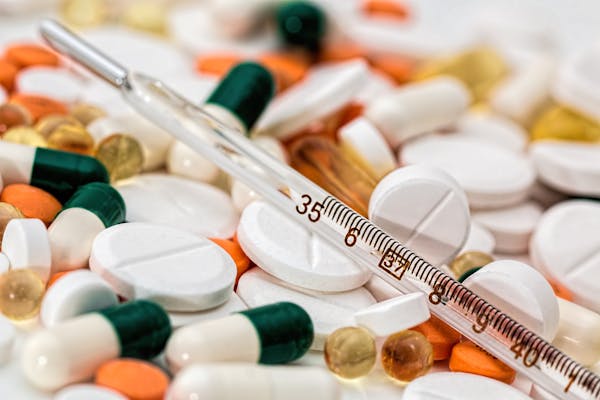Antibiotic treatments
Antibiotic treatments
Antibiotics are a class of drugs that are used to treat infections caused by bacteria. They work by killing the bacteria or stopping them from growing. Antibiotics are usually given by mouth in the form of pills, capsules, or liquids. Some common antibiotics include amoxicillin, ciprofloxacin, and erythromycin. Antibiotics are typically used only for bacterial infections. They will not work on viral infections, such as the flu, common cold, or bronchitis.

What are antibiotics?
Antibiotics are medicines that fight infections caused by bacteria. They work by killing the bacteria or stopping them from multiplying. Antibiotics are usually taken by mouth in the form of pills, capsules, or liquids, but some types can be given as an injection.
Most antibiotics need to be taken for 7 to 14 days. You should start to feel better a day or two after you start taking them. If you don't feel better after 3 days, call your doctor. Never stop taking an antibiotic early unless your doctor tells you to do so.
If you take antibiotics too often, they can lose their effectiveness. That's why it's important to only use them when prescribed by a doctor. When used correctly, antibiotics can save lives.

How do antibiotics work?
Most antibiotics work by either killing bacteria or preventing them from reproducing. To do this, they target different parts of the bacterial cell. For example, some antibiotics interfere with the bacterial cell’s ability to make protein, while others prevent the cell from dividing.
Some antibiotics, such as penicillin, kill bacteria by directly attacking their cell walls. This causes the cells to burst and die. Other antibiotics, such as erythromycin and tetracycline, work by inhibiting the bacterial cell’s ability to produce proteins. Without the ability to produce proteins, the bacteria cannot grow and reproduce.
Still other antibiotics, such as chloramphenicol and sulfonamides, inhibit the bacterial cell’s ability to divide. This prevents the bacteria from replicating and can eventually lead to their death.
Types of antibiotics
There are many different types of antibiotics available, and they can be classified in a variety of ways. Some common classification schemes include:
-By their mechanism of action: bactericidal vs. bacteriostatic
-By their spectrum of activity: broad-spectrum vs. narrow-spectrum
-By their chemical structure: natural vs. synthetic
Bactericidal antibiotics kill bacteria outright, while bacteriostatic antibiotics simply prevent the bacteria from growing. Broad-spectrum antibiotics are effective against a wide range of bacteria, while narrow-spectrum antibiotics are only effective against a limited range of bacteria. Natural antibiotics are derived from living organisms (e.g. plants, fungi, etc.), while synthetic antibiotics are man-made chemicals.
Some specific examples of antibiotic types include penicillins (like amoxicillin), cephalosporins (like cefazolin), tetracyclines (like doxycycline), macrolides (like azithromycin), and fluoroquinolones (like levofloxacin).
Why is it important to take antibiotics when needed?
Antibiotics are a type of medication that is used to treat infections caused by bacteria. They work by killing the bacteria or preventing them from growing. Antibiotics are usually taken by mouth in the form of pills, capsules, or liquids.
There are many different types of antibiotics available, and they are often grouped together based on how they work. For example, there are broad-spectrum antibiotics that can be used to treat a wide variety of bacterial infections, and there are narrow-spectrum antibiotics that are only effective against certain types of bacteria.
It is important to take antibiotics when needed because they can help to clear up an infection and prevent it from spreading. However, it is also important to use them correctly so that the bacteria do not become resistant to the antibiotic. When this happens, the antibiotic will no longer be effective against that particular type of bacteria.
What do antibiotics treat?
Antibiotics are most commonly used to treat infections caused by bacteria. They can also be used to treat some infections caused by other types of organisms, including some parasites and fungi. In addition, antibiotics may be used to prevent infection in people who are at risk for certain types of infections.

There are many different types of antibiotics, and each type is effective against a particular group of bacteria or other organisms. Antibiotics can be taken orally (by mouth) or intravenously (through a vein). Some antibiotics are applied directly to the skin or eyes.
Side effects
Most antibiotics are generally well tolerated and have few side effects. The most common side effects are nausea, vomiting, diarrhea, and rashes. These side effects are usually mild and go away on their own. More serious side effects are rare but can include allergic reactions, Clostridium difficile colitis, and Stevens-Johnson syndrome. If you experience any of these side effects, contact your doctor right away.
Allergy
Antibiotic treatments are often used to treat infections. However, some people may experience allergies to antibiotics. Symptoms of an antibiotic allergy can include:
-Hives
-Itchy skin
-Rash
-Wheezing
-Difficulty breathing
-Anaphylaxis
If you have any of these symptoms after taking an antibiotic, seek medical attention immediately. You may be given a different antibiotic or other treatment.
Interactions
Antibiotics are drugs that fight bacteria in your body. They work by killing the bacteria or by stopping them from growing. You may need to take antibiotics to treat an infection.
There are many different types of antibiotics, and each one works differently. Some antibiotics work against a wide range of bacteria, while others only work against specific types.
It's important to take the right antibiotic for the infection you're treating. Taking the wrong antibiotic can delay treatment and allow the infection to spread.
When you take an antibiotic, it's important to follow the instructions carefully. This includes taking the entire course of antibiotics, even if you feel better after a few days. Skipping doses or stopping early can allow bacteria to continue to grow and cause the infection to come back.
How to use
When it comes to antibiotic treatments, there are a few things you need to keep in mind. First and foremost, make sure you follow your doctor’s orders. They will know how much of the medication you need to take and for how long.
Secondly, do not skip any doses. It is important that you take the full course of antibiotics, even if you start feeling better. If you stop taking them too soon, the infection could come back stronger and be more difficult to treat.
Lastly, remember that antibiotics are not a cure-all. They will not work on viral infections like the common cold or flu. And they can have side effects like upset stomach and diarrhea. So be sure to talk to your doctor about any concerns you may have before starting an antibiotic treatment.
What causes antibiotic resistance?
It is important to understand that antibiotic resistance does not mean that the antibiotics are no longer effective. Antibiotic resistance occurs when bacteria evolve and develop the ability to survive even in the presence of antibiotics.
There are many factors that can contribute to the development of antibiotic resistance, including:
• Overuse of antibiotics: One of the most common reasons for the development of antibiotic resistance is the overuse or misuse of these drugs. When antibiotics are used too often, or for conditions they are not intended to treat (such as viral infections), this can give rise to bacteria that are resistant to their effects.
• Poor infection control: Another major contributor to antibiotic resistance is poor infection control. This can include things like not washing your hands properly, or not disinfecting surfaces properly. When bacteria are able to spread easily, this increases the chances that they will come into contact with antibiotics and potentially develop resistance.
• Use of low-quality antibiotics: Using low-quality or counterfeit antibiotics also contributes to antibiotic resistance. These products may contain sub-therapeutic levels of active ingredients, or none at all. This means that bacteria are exposed to sub-optimal levels of antibiotics, which can allow them to develop resistance.
Mutations, a ‘natural phenomenon’
Mutations are a natural phenomenon that can lead to the development of antibiotic resistance. Antibiotic resistance occurs when bacteria mutate and become resistant to the antibiotics that are used to treat them. This can happen when antibiotics are overused or misused, and it can pose a serious threat to public health.
Combating antibiotics
The overuse of antibiotics has led to the development of antibiotic-resistant bacteria. These bacteria are difficult to treat and can cause serious illnesses. The best way to combat antibiotic resistance is to use antibiotics only when they are needed.
When you are prescribed an antibiotic, take it exactly as your doctor tells you. Do not skip doses and do not stop taking the antibiotic until you have completed the entire course of treatment. Even if you feel better, it is important to finish the entire course of medication to make sure all the bacteria are killed.
It is also important to practice good hygiene habits to help prevent the spread of infection. Wash your hands regularly with soap and water, and avoid touching your face with your hands. Be sure to clean surfaces that may be contaminated with bacteria, such as doorknobs, countertops, and light switches.
‘Overuse and underuse’ of antibiotics
The overuse and underuse of antibiotics are both problems that can lead to the development of antibiotic resistance. When antibiotics are used too frequently, bacteria can develop resistance to them, making the antibiotics less effective. On the other hand, when antibiotics are not used enough, bacteria can also develop resistance. If a person has an infection and does not finish their course of antibiotics, the bacteria may become resistant to that antibiotic. This is why it is important to only use antibiotics when they are needed and to finish the entire course even if you feel better.


Comments
Post a Comment